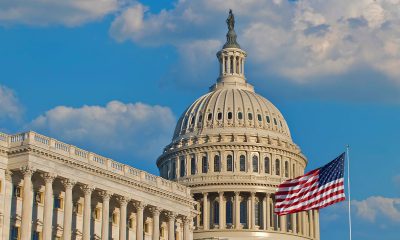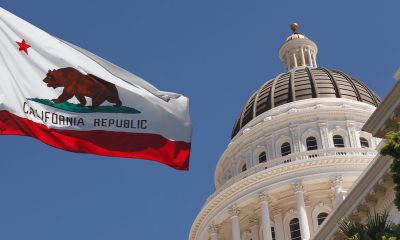Bay Area
California Ports to Receive Over $1 Billion in Federal Funds to Decarbonize
Last week, U.S. Senator Alex Padilla (D-Calif.) announced that the Environmental Protection Agency (EPA) will allocate over $1 billion to seven California ports for zero-emission (ZE) infrastructure and climate management plans. In an Oct. 29 press release, Padilla said this funding, part of the EPA’s Clean Ports Program and supported by the Inflation Reduction Act, aims to reduce greenhouse gas emissions and improve air quality at ports nationwide.

By Bo Tefu, California Black Media
Last week, U.S. Senator Alex Padilla (D-Calif.) announced that the Environmental Protection Agency (EPA) will allocate over $1 billion to seven California ports for zero-emission (ZE) infrastructure and climate management plans.
In an Oct. 29 press release, Padilla said this funding, part of the EPA’s Clean Ports Program and supported by the Inflation Reduction Act, aims to reduce greenhouse gas emissions and improve air quality at ports nationwide.
Among the grants, the Port of Los Angeles received over $411 million, the largest award in the country. California ports are vital to the national economy, handling about 40% of containerized imports and 30% of exports.
“California’s ports move the goods that power our economy. This historic investment in our ports is a major step forward in accelerating the zero-emission infrastructure transition,” said Padilla.
Port of Los Angeles Executive Director Gene Seroka and fellow port officials echoed Padilla’s sentiments, with plans to acquire over 400 pieces of ZE cargo handling equipment, reducing emissions by 41,500 tons annually.
“This transformative investment will be a tremendous boost to our efforts to meet our ambitious zero emission goals, improve regional air quality, and combat climate change while accelerating the port industry’s transition to zero emissions across the country,” said Seroka.
Other ports, including Oakland, Stockton, San Diego, and San Francisco, will also use their grants to transition to ZE operations, improve regional air quality, and create job opportunities.
The EPA’s funding will support various projects, from electrifying cargo terminals to establishing the first high-speed zero-emission ferry network in the U.S. Ports will collaborate with various stakeholders to ensure these investments benefit their surrounding communities.
The port of Hueneme in Ventura County and the Port of Redwood City on the Southern San Francisco Bay will also receive funding, respectively.
Alameda County
Seth Curry Makes Impressive Debut with the Golden State Warriors
Seth looked comfortable in his new uniform, seamlessly fitting into the Warriors’ offensive and defensive system. He finished the night with an impressive 14 points, becoming one of the team’s top scorers for the game. Seth’s points came in a variety of ways – floaters, spot-up three-pointers, mid-range jumpers, and a handful of aggressive drives that kept the Oklahoma City Thunder defense on its heels.

By Y’Anad Burrell
Tuesday night was anything but ordinary for fans in San Francisco as Seth Curry made his highly anticipated debut as a new member of the Golden State Warriors. Seth didn’t disappoint, delivering a performance that not only showcased his scoring ability but also demonstrated his added value to the team.
At 35, the 12-year NBA veteran on Monday signed a contract to play with the Warriors for the rest of the season.
Seth looked comfortable in his new uniform, seamlessly fitting into the Warriors’ offensive and defensive system. He finished the night with an impressive 14 points, becoming one of the team’s top scorers for the game. Seth’s points came in a variety of ways – floaters, spot-up three-pointers, mid-range jumpers, and a handful of aggressive drives that kept the Oklahoma City Thunder defense on its heels.
One of the most memorable moments of the evening came before Seth even scored his first points. As he checked into the game, the Chase Center erupted into applause, with fans rising to their feet to give the newest Warrior a standing ovation.
The crowd’s reaction was a testament not only to Seth’s reputation as a sharpshooter but also to the excitement he brings to the Warriors. It was clear that fans quickly embraced Seth as one of their own, eager to see what he could bring to the team’s championship aspirations.
Warriors’ superstar Steph Curry – Seth’s brother – did not play due to an injury. One could only imagine what it would be like if the Curry brothers were on the court together. Magic in the making.
Seth’s debut proved to be a turning point for the Warriors. Not only did he contribute on the scoreboard, but he also brought a sense of confidence and composure to the floor.
While their loss last night, OKC 124 – GSW 112, Seth’s impact was a game-changer and there’s more yet to come. Beyond statistics, it was clear that Seth’s presence elevated the team’s performance, giving the Warriors a new force as they look to make a deep playoff run.
Activism
Oakland Post: Week of November 26 – December 2, 2025
The printed Weekly Edition of the Oakland Post: Week of November 26 – December 2, 2025

To enlarge your view of this issue, use the slider, magnifying glass icon or full page icon in the lower right corner of the browser window.
Activism
Oakland Post: Week of November 19 – 25, 2025
The printed Weekly Edition of the Oakland Post: Week of November 19 – 25, 2025

To enlarge your view of this issue, use the slider, magnifying glass icon or full page icon in the lower right corner of the browser window.
-

 Activism4 weeks ago
Activism4 weeks agoOakland Post: Week of November 5 – 11, 2025
-

 Activism3 weeks ago
Activism3 weeks agoOakland Post: Week of November 12 – 18, 2025
-

 Activism2 weeks ago
Activism2 weeks agoIN MEMORIAM: William ‘Bill’ Patterson, 94
-

 Activism3 weeks ago
Activism3 weeks agoHow Charles R. Drew University Navigated More Than $20 Million in Fed Cuts – Still Prioritizing Students and Community Health
-

 #NNPA BlackPress3 weeks ago
#NNPA BlackPress3 weeks agoThe Perfumed Hand of Hypocrisy: Trump Hosted Former Terror Suspect While America Condemns a Muslim Mayor
-

 #NNPA BlackPress3 weeks ago
#NNPA BlackPress3 weeks agoProtecting Pedophiles: The GOP’s Warped Crusade Against Its Own Lies
-

 Bay Area3 weeks ago
Bay Area3 weeks agoNo Justice in the Justice System
-

 #NNPA BlackPress4 weeks ago
#NNPA BlackPress4 weeks ago2026 Subaru Forester Wilderness Review: Everyday SUV With Extra Confidence


























































